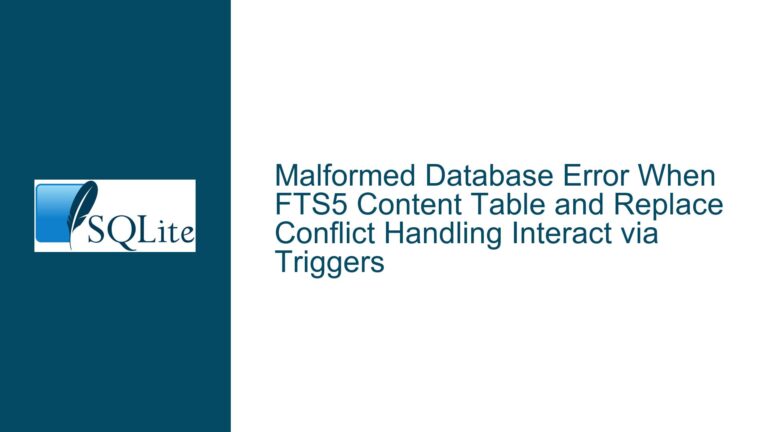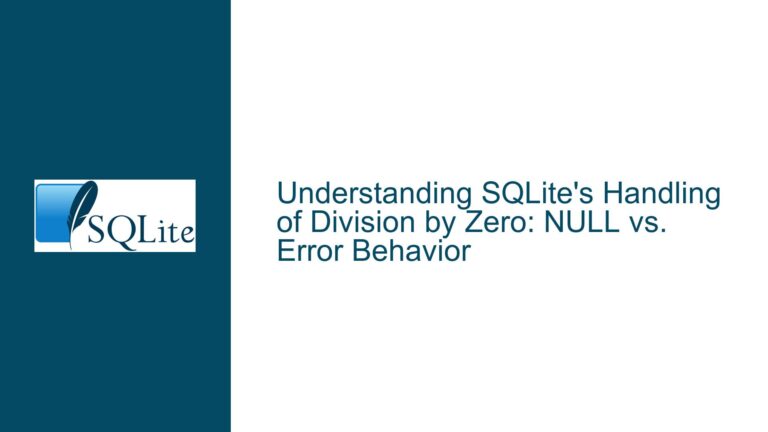Handling UNIQUE Index Creation on Tables with Existing Duplicate Data
Understanding UNIQUE Index Creation Constraints in SQLite
When attempting to create a UNIQUE index on an existing SQLite table, the operation will fail if the table contains rows with duplicate values in the column(s) targeted by the index. This occurs because SQLite enforces the uniqueness constraint at the moment of index creation by scanning all existing rows in the table. The database engine performs an implicit check for duplicate values in the indexed columns. If duplicates are detected, SQLite aborts the index creation process and returns an error message stating that the UNIQUE constraint was violated. This behavior is fundamental to SQLite’s design philosophy of strict data integrity enforcement but is not explicitly documented in the official SQLite documentation’s section on CREATE INDEX.
The error message generated during this event typically follows the pattern: Runtime error: UNIQUE constraint failed: <table_name>.<column_name>. This message indicates that the database engine identified at least two rows with identical values in the column(s) specified for the UNIQUE index. The failure is atomic: SQLite ensures that no partial index is created, and the transaction is rolled back to maintain database consistency. This has critical implications for applications that rely on schema migration scripts or dynamic index creation, as unhandled errors may disrupt deployment pipelines or runtime operations.
The absence of explicit documentation about this behavior creates ambiguity for developers working with legacy datasets or migrating schemas. For instance, a developer might assume that SQLite would automatically deduplicate records or create the index while ignoring conflicts—neither of which occurs. Understanding this constraint is essential for designing robust data validation workflows, especially when dealing with tables that have evolved without prior uniqueness enforcement. The problem becomes more complex in distributed systems where multiple nodes might have independently inserted data without coordination, making retrospective uniqueness enforcement challenging.
Common Scenarios Leading to UNIQUE Index Creation Failures
Duplicate data in SQLite tables can originate from multiple sources, often rooted in incomplete validation logic during data insertion or migration processes. One frequent scenario involves legacy systems where applications initially allowed non-unique entries in a column that later requires uniqueness. For example, a user database might have permitted duplicate email addresses during early development phases but later requires email uniqueness as part of a security upgrade. If the column was not validated at the application layer before insertion, attempting to enforce uniqueness retroactively via a UNIQUE index will fail until duplicates are resolved.
Data migration from external sources—such as CSV imports, third-party APIs, or merged databases—is another common cause. When importing data without pre-processing checks for uniqueness, duplicate entries can inadvertently enter the system. Consider a product inventory table merging data from two acquisitions: if both datasets contain products with identical SKUs but different metadata, a UNIQUE index on the SKU column cannot be created until conflicts are resolved. Similarly, ETL (Extract, Transform, Load) pipelines that lack deduplication steps may introduce duplicates during batch operations.
Concurrent write operations in multi-threaded or distributed environments can also lead to transient duplicates that persist long enough to block index creation. While SQLite’s locking mechanisms prevent simultaneous writes to the same database connection, applications using multiple connections or external processes might encounter race conditions where duplicate entries are inserted before a UNIQUE index is applied. This is particularly problematic in embedded systems or mobile applications where SQLite is often used, and sporadic connectivity might lead to uncoordinated data synchronization.
Schema design oversights, such as assuming uniqueness based on application logic rather than database constraints, contribute significantly to this issue. For instance, a developer might design a table where a combination of columns is expected to be unique due to business rules but neglect to enforce this via a UNIQUE constraint or composite key. Over time, edge cases or erroneous data entry may introduce duplicates, which surface as obstacles when attempting to formalize the uniqueness requirement through an index.
Resolving Duplicate Data Conflicts During UNIQUE Index Implementation
To successfully create a UNIQUE index on a table with pre-existing duplicates, a systematic approach to identifying and resolving conflicts is required. The first step involves executing a diagnostic query to locate duplicate values. For a single column index, the query would group rows by the target column and count occurrences:
SELECT target_column, COUNT(*) AS duplicate_count
FROM target_table
GROUP BY target_column
HAVING duplicate_count > 1;
For composite indexes spanning multiple columns, all indexed columns must be included in the GROUP BY clause:
SELECT column1, column2, ..., COUNT(*) AS duplicate_count
FROM target_table
GROUP BY column1, column2, ...
HAVING duplicate_count > 1;
This query identifies groups of rows that violate the proposed uniqueness constraint. Once duplicates are located, the resolution strategy depends on the nature of the data and business requirements. Options include deleting redundant rows, merging data from conflicting rows into a single canonical record, or updating duplicate values to make them unique. For example, in a user table with duplicate emails, merging might involve preserving the most recently updated account and deleting older entries:
DELETE FROM users
WHERE rowid NOT IN (
SELECT MIN(rowid)
FROM users
GROUP BY email
);
This subquery selects the oldest row (by rowid) for each email group, deleting all others. For more complex merge operations—such as combining user preferences or order histories—additional application logic or manual intervention may be necessary.
If deletion is not feasible due to referential integrity constraints or auditing requirements, altering the duplicate values to achieve uniqueness is an alternative. This could involve appending sequence numbers to duplicate strings or adding timestamps to otherwise identical records. However, such transformations must align with the application’s data model to avoid introducing semantic inconsistencies.
After resolving duplicates, the UNIQUE index can be created:
CREATE UNIQUE INDEX idx_target_column ON target_table(target_column);
To prevent future duplicates, combine the index with application-layer validation and conflict resolution clauses in INSERT and UPDATE statements. SQLite’s ON CONFLICT mechanism provides granular control over how uniqueness violations are handled during data manipulation operations. For instance, using INSERT OR IGNORE or INSERT OR REPLACE clauses silently skips or overwrites conflicting rows, respectively:
INSERT OR IGNORE INTO target_table (target_column) VALUES ('example');
For tables requiring strict uniqueness without automatic resolution, omitting the ON CONFLICT clause ensures that any insertion violating the UNIQUE index will raise an error, which must then be handled by the application.
In scenarios where downtime must be minimized during index creation on large tables, consider using a temporary table to stage deduplicated data:
-- Create a temporary table with the desired structure and uniqueness constraints
CREATE TEMPORARY TABLE temp_table AS
SELECT DISTINCT * FROM target_table;
-- Drop the original table
DROP TABLE target_table;
-- Recreate the original table with the UNIQUE index
CREATE TABLE target_table (...);
CREATE UNIQUE INDEX idx_target_column ON target_table(target_column);
-- Restore data from the temporary table
INSERT INTO target_table SELECT * FROM temp_table;
-- Drop the temporary table
DROP TABLE temp_table;
This approach ensures data consistency while avoiding locks on the original table during deduplication. However, it requires sufficient storage for the temporary table and may complicate foreign key relationships, which must be reestablished manually.
For ongoing maintenance, implement periodic checks for duplicates using scheduled jobs or triggers. A trigger that fires before INSERT or UPDATE operations can enforce application-specific deduplication logic, complementing the UNIQUE index’s protection. Additionally, integrating data validation into CI/CD pipelines for schema migrations helps catch duplicates before they reach production environments. Tools like SQLite’s CHECK constraints or third-party data quality frameworks can automate these validations, reducing the likelihood of retrospective index creation failures.






